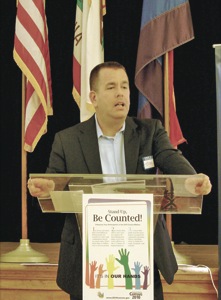san diego
U.S. Census Bureau reaches out to GLBT community
2010 form will recognize married same-sex couples who live together
Published Thursday, 08-Oct-2009 in issue 1137
Representatives for the U.S. Census Bureau hosted an outreach forum to inform the GLBT community about its upcoming 2010 count, last Wednesday, Sept. 30 at the San Diego LGBT Community Center.
“We want people to know that the Census is coming, that this is what it looks like, that this is why it’s important,” said U.S. Census Bureau LGBT Communities Partnership Specialist Matt Weinstein. “We [also] need you to tell your community to fill it out and explain to them why it’s important.”
Conducted every 10 years, the U.S. Census counts the number of people living in the country through a questionnaire mailed to and completed by each household.
The questionnaire, a two-page form for households with less than three people or a multi-page form for households with more than three people, asks the head of each household to state the number of people in the house, define their relationship to one another and identify each person’s race, sex and age.
Private and public organizations use the data to determine everything from congressional seats to social services funding.
“We have to absolutely make sure that every one of our members of our community gets counted, because [the total] correlates to programs, which … pay for buildings like The Center, which create projects like the Youth Housing Project, help fund things like the Ryan White Care Act and help provide HIV/AIDS projects in our community, said District 3 City Councilmember Todd Gloria. “It’s so critical that this count is done well.”
The Census also provides information about the nation’s population, including, the number of same-sex couples living together. However, until recently, the bureau did not acknowledge such data.
Same-sex couples who live together were first able to report being in such relationships on the 1990 Census when the bureau added the category “unmarried partner” to its list of responses to the question: “What is your relationship to the people you live with?” But “If two people of the same sex checked that they were unmarried partners living together, it was assumed that one person was making a mistake on their sex,” Weinstein said.
“So a guy and a guy became a guy and a girl and a girl and a girl became a girl and a guy,” said U.S. Census Bureau Field Division Assistant Division Chief Timothy Olson.
But by the 2000 Census, the bureau recognized that the category unmarried partner could include same-sex couples who lived together and reported that nearly 600,000 such relationships existed that year.
Next year’s Census will identify same-sex couples who live together as either married or unmarried, since several states now legally recognize same-sex marriage.
But while the 2010 Census will record same-sex couples who live together, it will not record the number of people living in the U.S. who identify as gay, lesbian or bisexual.
“There is no ‘gay’ box,” said Weinstein. “The Census will not know what my sexual orientation is based on this form.”
Nor will the 2010 Census record the number of transgender people living in the U.S.
“Unfortunately, given the way the questionnaire is currently structured, there is no way to identify a gender identity that is different from one’s biological sex,” Weinstein said.
Weinstein added that the Census has been working with the National Center for Transgender Equality to “do the job in counting the community” and advised that transgender people should “pick whichever box they fill best represents who they are.”
As far as confidentiality is concerned, Weinstein said that completed Census questionnaires are kept safe and secure and will not be released for 72 years after the information is collected. If bureau employees were to divulge information, they could be fined $250,000 and jailed for five years, he added.
Nor does the Census share the information with other government agencies, Weinstein said.
“The Census is not going to the military; it’s not going to immigration. It’s not going to the IRS, not the FBI or the White House.”
At the end of the forum, Weinstein asked the audience to create and participate in a local committee to inform the local GLBT community about the Census.
“Most of the population doesn’t want to hear it from me; they want to hear it from you. They want to hear it from the people they know, people they trust. And we’re counting on that,” Weinstein said. The committee would direct its attention to informing different sectors of the GLBT community, including faith communities and people of color, about the Census and develop promotional materials to promote the Census to them.
For more information about starting and/or participating in a local outreach committee, call Matt Weinstein at 213-494-6105 or e-mail him at matthew.e.weinstein@census.gov.
All U.S. households will receive the 2010 Census questionnaire next March.
|
|
Copyright © 2003-2025 Uptown Publications


